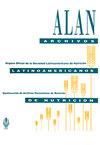Relação entre ganho de peso e consumo de refrigerantes em adolescentes brasileiros do ensino médio
IF 0.3
4区 医学
Q4 NUTRITION & DIETETICS
引用次数: 0
Abstract
A adolescência é um período de diversas transformações, sendo observadas mudanças em relação à nutrição, que podem resultar em excesso de peso corporal. Assim, o estudo teve como objetivo verificar a associação entre excesso de peso corporal e consumo de refrigerante em adolescentes escolares estratificado por sexo. Trata-se de um estudo transversal, realizado com estudantes do ensino médio. Utilizou-se um questionário autoaplicável. A variável desfecho foi a mediana do escore de IMC (eutrófico e excesso de peso) e o consumo de refrigerante foi a variável de exposição principal. Foi utilizado o modelo de Poisson, estratificado por sexo. Participaram do estudo 1.225 adolescentes, 53,4% do sexo feminino e 15,6% consumiam refrigerante diariamente. Nos adolescentes eutróficos não houve associação de consumo de refrigerantes e zIMC. Nos meninos com excesso de peso e consumo de refrigerante mais de duas vezes na semana apresentaram maior chance de estarem acima da mediana de zIMC. Os resultados apontaram que o consumo diário de refrigerantes por adolescentes do sexo masculino com excesso de peso pode aumentar as chances de ter zIMC ainda mais alto, reforçando assim, a necessidade de medidas que visem a redução do consumo de refrigerante. Adolescence is a period of several changes, with changes related to nutrition, which can result in excess body weight. Thus, the study aimed to verify the association between excess body weight and soft drink consumption in school adolescents stratified by sex. This is a cross-sectional study, carried out with high school students. A self-administered questionnaire was used. The outcome variable was the median BMI score (eutrophic and overweight) and soft drink consumption was the main exposure variable. The Poisson model, stratified by sex, was used. The sample consisted of 1,225 adolescents, which 53.4% were female and 15.6% consumed soft drinks daily. In eutrophic adolescents, there was no association between consumption of soft drinks and the BMI Z-score. In overweight boys and soda consumption more than twice a week, they were more likely to be above the BMI Z-score median. The results showed that the daily consumption of soft drinks by overweight male adolescents may increase the chances of having even higher BMI Z-score, thus reinforcing the need for measures aimed at reducing the consumption of soft drinks.巴西高中青少年体重增加与软饮料消费的关系
青春期是一个经历了几次转变的时期,可以观察到与营养有关的变化,这可能导致体重超标。因此,该研究旨在验证按性别分层的在校青少年超重与软饮料消费之间的关系。这是一项针对高中生的横断面研究。使用了一份自我管理的问卷。结果变量是BMI评分中位数(富营养化和超重),软饮料的消费是主要的暴露变量。采用泊松模型,按性别分层。共有1225名青少年参与了这项研究,53.4%为女性,15.6%的青少年每天饮用软饮料。在营养丰富的青少年中,饮用软饮料与zBMI之间没有关联。超重且每周饮用软饮料超过两次的男孩更有可能高于zBMI中位数。结果表明,超重男性青少年每天饮用软饮料会增加zBMI更高的几率,从而加强了减少软饮料消费措施的必要性。青春期是一个由多种变化组成的时期,这些变化与营养有关,可能导致体重超标。因此,该研究旨在验证按性别分层的在校青少年超重与软饮料消费之间的关系。这是一项针对高中生的横断面研究。使用了一份自我管理的问卷。结果变量是BMI评分中位数(富营养化和超重),软饮料消费是主要的暴露变量。采用按性别分层的泊松模型。该样本由1225名青少年组成,其中53.4%为女性,15.6%每天饮用软饮料。在营养丰富的青少年中,软饮料的消费与BMI Z评分之间没有关联。在超重男孩和每周喝两次以上苏打水的情况下,他们更有可能高于BMI Z分中位数。结果表明,超重男性青少年每天饮用软饮料可能会增加BMI Z评分更高的机会,从而加强了减少软饮料消费措施的必要性。
本文章由计算机程序翻译,如有差异,请以英文原文为准。
求助全文
约1分钟内获得全文
求助全文
来源期刊
CiteScore
0.50
自引率
0.00%
发文量
31
期刊介绍:
Archivos Latinoamericanos de Nutrición (ALAN) is the official publication of the Sociedad Latinoamericana de Nutición (SLAN), for the dissemination of knowledge in the fields of food and nutrition, principally throughout the American Hemisphere. Articles in Spanish, English, Portuguese and French are accepted, both from the Society members and from nonmembers, in the following categories: 1. General articles (critical scientific reviews); 2. Research articles (originals); 3. Papers in applied nutrition (analytical results from intervention programs and discussion of reconmendations of practical application), and 4. Letters to Editor (short comments of general interest or about scientific facts and results previously published in Archives).

 求助内容:
求助内容: 应助结果提醒方式:
应助结果提醒方式:


